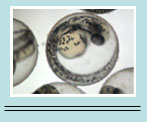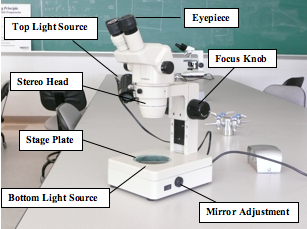

Home
Common Techniques
Classroom Experiments
Virtual Experiments
Tutorials
Games
Glossary
Links
Publishing
Opportunities
About This Site
Contact Us
ZFIN
Cite Us
How to use a Stereomicroscope
Stereomicroscopes operate on low power and have a limited range of magnification. They are also called dissecting microscopes because they have a large stage and a large amount of working room. This enables us to simultaneously dissect and observe the specimens. In order to make careful observations, several steps must be taken first:

1. Set your microscope on a tabletop or another flat, sturdy surface where you will have plenty of room to work. Plug the microscope’s power cord into an outlet, making sure that the excess cord is out of the way so no one can trip over it or pull it off of the table.
2. Switch on the light source(s). If you will be looking at a microscope slide or other transparent object, lighting will work best from the bottom. If the specimen you are viewing is opaque or solid (light cannot pass through it from below), use lighting from the top so that the light can reflect off the specimen’s surface. For stained zebrafish embryos, light from above with a white background under the specimen works well.
3. Center your specimen on the stage plate. If your specimen is thin and flat, or if its edges curl up easily, try using the stage clips to hold it in place. To do this, pull up the pointed end of one stage clip and slide it over one end of the specimen, then do the same with the stage clip on the other side. Note: zebrafish are typically viewed in a Petri dish filled with water, and not on a slide.
4. Adjust the eyepiece(s) so that you can look through the microscope comfortably without straining your eyes. (See below for instructions on adjusting a stereo head).
5. If your stereomicroscope has a rotating objective turret, turn it so that the marking on the objective you want to use is facing the front of the microscope. To determine the total magnification of your microscope, multiply the magnification level of the eyepiece lens by that of the objective lens.
6. While looking through the eyepiece(s), slowly turn the focus knob until the specimen comes into view. Once you can see the outline of the specimen, turn even more slowly to focus as sharply as possible. If you are not able to see anything, try moving the specimen around slightly on the stage plate to make sure it is directly below the objective lens and then try focusing again. Once you have focused on the specimen, you can move it around to see its other parts. You may have to refocus slightly on each new area. Note: with a stereomicroscope, you will often be viewing three-dimensional round zebrafish that have many different levels. You will not be able to focus every feature clearly at the same time.
7. When you are finished using your microscope, turn off the switch, remove the specimen, unplug the power cord, and cover the microscope with its dust cover. Store your microscope in a place where it will not be damaged from extreme hot or cold temperatures.
Adapted from: http://www.hometrainingtools.com/articles/using-a-stereo-microscope-science-teaching-tip.html